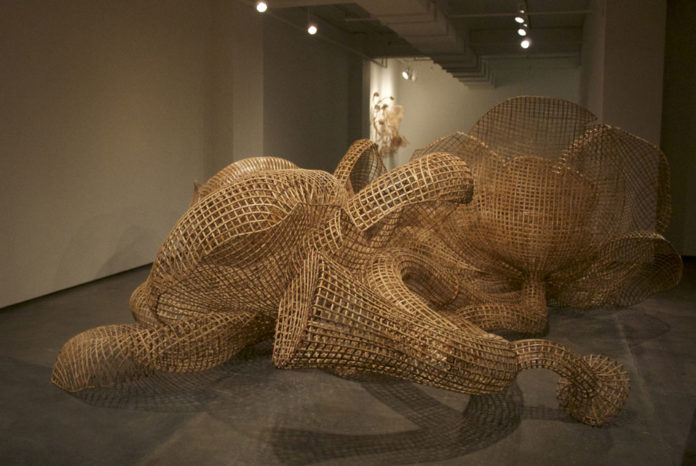The Crow Collection of Asian Art is presenting a solo exhibition of the work of Sopheap Pich, recognized today as Cambodia’s most internationally prominent contemporary artist. The exhibition features his large-scale sculpture, Rang Phnom Flower, Pich’s largest and most ambitious single-form sculpture to date. Measuring 25 feet in length, its complex construction is composed of hundreds of strands of rattan and bamboo. This exhibition also features the loan of an original French 19th-century, hand-painted botanical dictionary with illustrations of this plant species from the Botanical Research Institute of Texas (BRIT).
Pich is a world-renowned artist whose works have been featured in numerous international museum exhibitions and biennials throughout the world, notably Documenta 2012, and a 2013 solo exhibition at The Metropolitan Museum of Art (Cambodian Rattan: The Sculptures of Sopheap Pich), which was the museum’s first solo show ever given to a contemporary Southeast Asian artist. Most recently, his work is currently on view in the main exhibition at this year’s 57th International Venice Biennale (La Biennale di Venezia), Viva Arte Viva, curated by Christine Macel, chief curator of the Centre Pompidou (Paris). Additionally, the world’s premier museums have collected his work, including The Metropolitan Museum of Art (New York), Solomon R. Guggenheim Museum (New York), Centre Georges Pompidou (Paris), M+ Museum for Visual Culture (Hong Kong), Singapore Art Museum, Queensland Art Gallery (Brisbane), San Francisco Museum of Modern Art, Albright-Knox Art Gallery (Buffalo) and the Cleveland Museum of Art.
“Sopheap’s works, particularly his newest sculpture Rang Phnom Flower, reflects changing realities and mediates between representation and abstraction,” said Jacqueline Chao, curator of Asian Art at the Crow Collection of Asian Art. “This exhibition examines our perceptual limits, but also invites us to consider how artistic modernities are defined in today’s global art world.”
Pich was born in Battambang, Cambodia, in 1971. He moved with his family to the U.S. in 1984 and received a Master of Fine Arts from the School of the Art Institute of Chicago in 1999. In 2002, he returned to Phnom Penh, Cambodia, where he is currently based.
Pich is known for working with local materials such as bamboo, rattan, burlap from rice bags, beeswax and earth pigments gathered from around Cambodia and making sculptures that are inspired by bodily organs, vegetal forms, and abstract geometric structures. His childhood experiences during the genocidal conditions of late 1970s Cambodia and the Khmer Rouge regime (1975-1979) has had a lasting impact on his work, informing its themes of time, memory and the body.
Pich’s sculpture Rang Phnom Flower represents the cannonball tree (“rang phnom” in Khmer), which in Southeast Asia is associated with the sal tree under which the Buddha was born. This tree is often planted near Buddhist temples, and many can be found around the temples near Pich’s studio on the outskirts of Phnom Penh.
The cannonball tree originated in the Americas and was introduced by Europeans to Sri Lanka, where it was soon revered for its resemblance to the sal tree. (The sal tree does not grow in tropical climates.) It was then brought to Southeast Asia by Sri Lankans, who were responsible for the revitalization of Buddhism in that region.
Pich’s tree is created at enormous over-sized scale. While conveying the power of nature, the sculpture also brings forward the plant’s naturally abstract qualities by using precise grid-like structure and geometric shapes in order to consider concepts of scale, and illustrating how the large can be found within the small.
“It took a team of five people to help me create Rang Phnom Flower, my most ambitious single-form sculpture to date,” says Pich. “I’m very honored that it will be prominently displayed at the Crow Collection of Asian Art, the Asian Art Museum of Dallas.”
Hidden Nature: Sopheap Pich is curated by Jacqueline Chao, curator at the Crow Collection of Asian Art. The exhibition is on view in the Mezzanine of the Crow Collection through January 7, 2018.

























